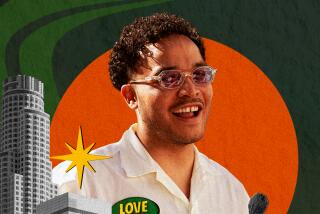Health Care Van’s on a Roll
- Share via
Since the health van started coming to Santa Ana elementary schools, immunization rates have doubled. The rates of physical exams have jumped. And the program--a partnership among public agencies and hospitals--has served thousands of poor children, many of whom never had any medical care before in their lives.
“When Healthy Tomorrows was just a concept, some doctors volunteered to do some health screenings at two or three of the inner-city schools in Santa Ana,” said Diane Thomas, county spokeswoman. “The result was that 88% of the students had [untreated] health needs.”
Eligible students and their preschool-age siblings receive free screenings, immunizations and referrals at the program’s 36-foot-long van, which contains two fully equipped exam rooms and serves poor students at 10 schools.
Although the program has received grants for some of its operating expenses, key components are provided by the partners--medical personnel from Children’s Hospital of Orange County (CHOC), social workers from the county Social Services Agency, office space and administrative services from the Santa Ana Unified School District, and technical assistance from Cal State Fullerton.
A second van, funded by CHOC, will start making rounds next month to eight more schools, bringing the program’s annual caseload to 5,000 children.
Healthy Tomorrows was conceived in 1991 to reduce medical neglect in needy families after doctors noticed that many children with easily preventable diseases were being admitted to CHOC. After two years of planning, the van began making school stops in 1993 and has seen more than 13,000 children since.
But Healthy Tomorrows has its share of critics.
Nearly all the children it serves--98%--are Latino, and some say illegal immigrants are getting free medical services from the van. No one knows the immigration status of the young patients; no one asks.
“We don’t care,” said nurse practitioner Vicky Reiser. “We’re simply here to help the families living in this area. We try to make services available for families no matter who they are.”
*
Half of the children who visit the van have never seen a physician before. Before the program began, about 51% of Santa Ana elementary students had undergone state-mandated physicals. This year, 92% have. Immunization rates have jumped from 51% in 1992 to 100% this year.
Yolanda Cisnevos needed the state-required hepatitis B immunization and a tetanus booster shot before starting junior high school in the fall. When medical assistant Araceli Toledo gave the injections, the 11-year-old’s face showed no sign of discomfort.
Yolanda’s mother, also named Yolanda, has been bringing her four daughters, ages 4 to 11, to Healthy Tomorrows for four years.
The program began amid controversy. School trustees feared parents would come to rely on schools for noneducational services.
“It does keep parents, especially newer immigrants, dependent,” said trustee Rosemarie Avila, who has been against the program since its start. “They don’t really learn how to go out in the community and find their own resources.”
Reiser said the health services are necessary to help children learn.
“I guess it comes down to your philosophy about what a community should offer to community members,” she said. “For a child to go to school in poor health--clearly, they cannot learn.”
Avila also worries about a hidden, ulterior motive of population control. She says grant funding is linked to companies that produce birth control pills and organizations that promote a zero-growth population goal.
“Through the child, they can have the whole family,” Avila said. “Parents have to meet with social workers and nurses and a whole staff of professionals that are going to work on family problems.”
Reiser said such charges have no basis in reality.
“I don’t know where she gets these ideas,” she said. “The thing that always frustrates me is that we have invited [critics] to come out and see what we do. We don’t ever even mention [birth control]. That never comes up.”
The program’s only goal is to help children in need, Reiser said. Without Healthy Tomorrows, she said, these children would probably go unchecked and untreated or possibly wind up at one of the illegal back-room clinics, where three county children have died in the past two years.
Even legal immigrants who are eligible for state-subsidized health care are often afraid of signing up, Reiser said.
“If they’re applying for their [citizenship] papers, they’re very hesitant to apply for any services,” she said. “We run into that every day.”
Children must be accompanied by a parent during any visit. Reiser regularly has to write notes to employers so the parents don’t lose their jobs.
One such note was for Flora Marcham, who packs clothing into boxes for a living. Her employer had given her a hard time about taking a few hours off to bring her daughter, Carla Garcia, to Healthy Tomorrows.
The 7-year-old girl had an earache and fever. Reiser tried to remove crayon fragments from her right ear but also found the left ear canal swollen and blocked. After prescribing antibiotics to fight the infection, she referred the first-grader to an ear, nose and throat specialist.
Hospitals and physicians’ organizations are regularly tapped to provide free or low-cost services for problems that need more serious attention. But the staff also focuses on preventive education for the parents. Cultural differences regularly figure into such conversations.
Some families from rural Mexico have only dealt with curanderas, or people who specialize in homeopathic care, such as herbal therapy. One young boy broke his arm, and his parents took him to see the curandera, who massaged the arm. A week later, when he was brought to Healthy Tomorrows, the family was persuaded to have his arm X-rayed.
“We don’t want to say ‘you’re wrong,’ Reiser said, “but we want to encourage them to seek medical care.”
More to Read
Sign up for Essential California
The most important California stories and recommendations in your inbox every morning.
You may occasionally receive promotional content from the Los Angeles Times.














